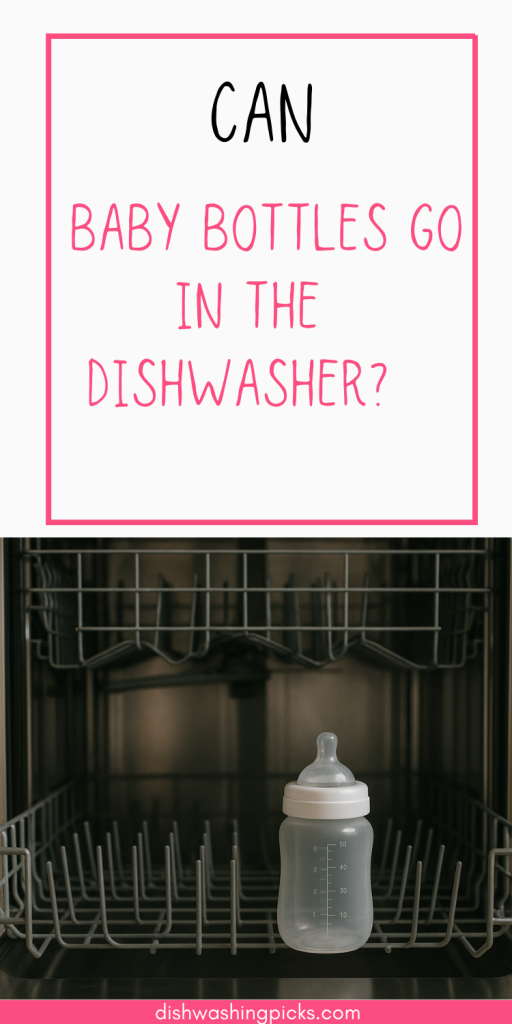
Alright, so picture this: you’ve finally gotten the baby down for a nap (hallelujah), you’re staring at the mountain of bottles in the sink, and the dishwasher is just right there—waiting, humming, practically begging you to toss everything in and hit start.
But then that little voice of panic kicks in:
“Wait… can I actually put baby bottles in the dishwasher? Like—is that even safe?”
Yep, it’s a common question. Especially when you’re sleep-deprived and just trying to survive one bottle-feeding at a time. So let’s settle it once and for all.
The short answer?
Yes! You can put baby bottles in the dishwasher.
But hold up—we’re not done yet. There are some “ifs” and “buts” involved. You didn’t think it would be that easy, did you?
Let’s break it all down so you know exactly how to do it the safe, clean, no-drama way.
What do pediatricians and experts say?
According to the CDC (Centers for Disease Control and Prevention), washing baby bottles in the dishwasher is totally fine as long as the dishwasher has a sanitize cycle and you follow a few simple steps.
Basically: it’s not just about tossing bottles in with last night’s spaghetti plate and hoping for the best. There’s a little method to the madness.
Here’s how to do it right:
1. Take everything apart
We’re talkin’ bottles, nipples, rings, caps, valves—if it can come off, it should come off. That way every nook and cranny gets properly cleaned and rinsed.
2. Rinse right away
You don’t want formula or breastmilk residue sitting around and turning into crusty science experiments. A quick rinse right after feeding makes a huge difference before they hit the dishwasher.
3. Use a dishwasher basket
If you don’t already have one of those little mesh or plastic baskets designed for baby bottle parts—do yourself a favor and get one. It keeps small items like nipples and rings from flying all over your dishwasher (and ending up melted on the bottom… not that I’m speaking from experience or anything).
4. Top rack only
Most bottles and parts should go on the top rack to avoid warping from the intense heat at the bottom. The top is way gentler, and still gets the job done.
5. Sanitize cycle, if possible
If your dishwasher has a “sanitize” or “high heat” cycle, now’s the time to use it. This helps kill off any leftover bacteria and gives you that nice peace of mind that everything’s squeaky clean.
Are all baby bottles dishwasher safe?
Most modern baby bottles are made from dishwasher-safe materials like BPA-free plastic, silicone, or glass. But—and this is a big but—always check the label or the brand’s website.
Some plastic bottles may not hold up well to high heat over time and could warp or crack. Others might be safe only on the top rack. When in doubt, hand wash or double-check before you toss them in.
Also, some fancy bottles (looking at you, anti-colic bottles with 12 different parts) might just clean better by hand. Sorry.
What about sterilizing?
Okay, so here’s a little bonus info, because this trips people up all the time:
- Dishwashing is cleaning.
- Sterilizing is killing every single germ and bacteria.
If your baby was born premature, has a weak immune system, or your pediatrician told you to be extra careful, you might need to sterilize bottles too—especially in the first 3 months. You can do this with boiling water, a microwave sterilizer, or an electric one.
But for healthy, full-term babies? Regular dishwashing with hot water and a sanitize cycle is totally fine after the early weeks.
So, dishwasher or hand wash?
Let’s be honest—hand washing 6+ bottles a day is no one’s idea of fun. If the dishwasher saves you time and your sanity, use it. Just be smart about it.
Use the basket. Use the top rack. Check your bottle instructions. And you’re golden.
That said, if you’re more of a “hand wash every time” kind of parent? Kudos. You do you. There’s no wrong way—as long as it’s clean.
Final thoughts?
So yes, baby bottles can totally go in the dishwasher. It’s not only safe—it’s practical. Just make sure you’re doing it right, and your bottles will be squeaky clean, sterilized (if needed), and ready for that next 2 a.m. feeding.
Because let’s be real… anything that makes baby life even 1% easier? That’s a win in my book.
Want more real-world parenting hacks, bottle care tips, or answers to the random questions that keep popping into your tired brain? Stick around. I got you.
